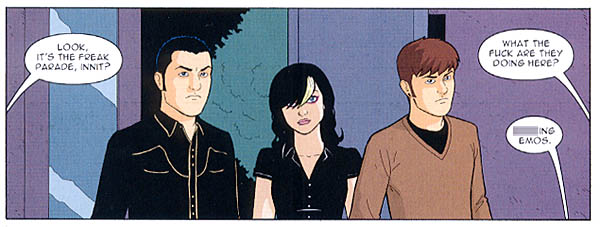 By Jamie McKelvie
By Jamie McKelvie
104 pages, color
Published by Image Comics
There’s an old chestnut about out there how there are only so many stories out there, and that everyone is just repeating them over and over again. It’s a slight exaggeration (you really have to break the stories down to their absolute basics in order for that to work) but the important point behind it all is that more often than not, it’s not what you’re telling in your story but rather how you’re telling it. I think that’s very much the case with Jamie McKelvie’s Suburban Glamour; the absolute core of the story is nothing you haven’t seen before, but it’s his storytelling abilities that make the comic shine.
 Astrid Johnson isn’t exactly the most popular girl in her school. She’s greeted at parties with comments like, "Look, it’s the freak parade, innit?" She and her friends are charitably referred to as emo. But she really doesn’t care about them. Instead she hangs out with her friends and dreams of eventually leaving the boring town of Lanbern. That chance might be coming sooner than she thinks—but she almost certainly wasn’t expecting that chance involving the return of long-forgotten imaginary friends, and creatures from the realm of faerie.
Astrid Johnson isn’t exactly the most popular girl in her school. She’s greeted at parties with comments like, "Look, it’s the freak parade, innit?" She and her friends are charitably referred to as emo. But she really doesn’t care about them. Instead she hangs out with her friends and dreams of eventually leaving the boring town of Lanbern. That chance might be coming sooner than she thinks—but she almost certainly wasn’t expecting that chance involving the return of long-forgotten imaginary friends, and creatures from the realm of faerie.
I suspect that McKelvie would agree that there’s nothing terribly new about a non-popular girl discovering that she has a previously unknown connection to a strange and magical world. After all, there are entire sub-genres of fiction devoted to that basic idea. What struck me about McKelvie’s take on the idea, though, was how well he brings his characters and their social lives to life. I love how natural he makes their dialogue and their interactions; it’s not sugarcoated or glamorized (no pun intended), but it all flows very smoothly and realistically. Astrid, Dave, and Chris’s friendship doesn’t need to be identified in the text as having existed a long time and strongly; you can tell by the way they tease each other, their knowledge of each other’s lives, and what buttons to push to get the appropriate reactions. It’s this that makes Suburban Glamour so especially appealing, because you want to see more of them. Changelings? Crafty imaginary friends? Ancient oaths? They all work well, don’t get me wrong, but it’s the characters that back these plot points that make them strong. Even the supporting cast get good moments throughout the story; there’s a moment towards the end of the book where Astrid confronts Aubrey about her secret that she’s been keeping from Astrid. What’s great about it is that there’s no gasp of discovery, no melodramatic moment, no over-the-top reaction. Instead the tone of the conversation between the two comes across very real, very believable; what could have been a groan-worthy moment instead works surprisingly well because of McKelvie’s ear for dialogue.

That said, what I think I like even more about Suburban Glamour is the fashion on display in McKelvie’s art. This is a book where characters actually own full wardrobes, and ones that are fashionable and trendy. There’s a scene early on in the first chapter where Astrid and her friends to go a party in the evening; they’ve clearly changed their clothes, and while all three are following their own basic fashion sense that we’ve seen earlier, there’s also a clear change in the level of clothing that they’re wearing. They’ve dressed up for the evening, and you can tell it. Every scene involves new costume changes, and it’s the sort of clothes that you really would see on high school students in this day and age. Even the characters from faerie manage to look glamorous and snazzy; their outfits are very different than what everyone else wears, but they still look good. Of course, the art does look good in regards to things other than the clothes on their backs. Like his art in Phonogram, McKelvie draws his characters with soft, smooth lines and really expressive faces. I really like how they move; especially in characters like Astrid they have such a level of energy and bounce to their bodies that you can almost see them move in each individual panel. Matthew Wilson and Guy Major do a good job with bringing McKelvie’s work into the color realm as well; the colors are gentle but pleasing, and bring a strong level of warmth to McKelvie’s drawings.
Suburban Glamour might look a little predictable (and to be honest, it is) but that’s now what you’re really coming for here. McKelvie’s clearly had these characters in his head for years, carefully refining and developing them so that they appeared on the page fully robust. I was really pleased to see that it’s clearly marked as a Volume 1, because I’d love to see where McKelvie will go from here; both in terms of characterization as well as even basic plot. There’s a lot of room for future stories to be told here, and hopefully we won’t have to wait too long to see them.
Purchase Links:
